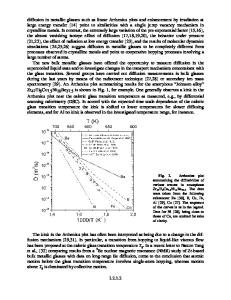Diffusion of Metallic Impumties in Semiconductor Thin Film
- PDF / 235,140 Bytes
- 5 Pages / 420.48 x 639 pts Page_size
- 31 Downloads / 397 Views
DrIFIFUSIIUN OF METALLIC IMPURITIES RN SIEMICONDUCTORI THIN IFILM ALEXANDER V. VAYSLEYB Columbia University, Henry Krumb School of Mines, New York, NY 10027
ABSTIRACT The diffusion transport of metal impurities in semiconductors is considered. Critical magnitude of dislocation density and critical sample size are obtained at which the diffusion kinetics change from the interstitial impurity regime of diffusion transport to the selfinterstitial regime or the vacancy regime. It is predicted that the critical density of dislocations decreases with increasing temperature. For at least the last twenty years the investigations of diffusion of metal impurities in Si and Ge semiconductors crystals have been given strong consideration, because this process is the basis for the manufacturing technology of VLSI. Unfortunately, there is still not a generally accepted theory of diffusion for certain important pairs, such as Au-Si, Ni-Si, Pt-Si . Also, the role of the sample size and defect density in diffusion transport has not been established. In the present communication we discuss the influence of the sample thickness on the diffusion kinetics and derive criteria for the change from the dissociative diffusion mechanism to the kickout mechanism. Also, we introduce the concept of critical density of dislocations in diffusion. This gives us the opportunity to choose the valid mechanism for description of diffusion transport. Earlier, it was shown that the diffusion transport of metallic impurities Au, Ni, Cu into Si and Ge crystals occurs with the assistance either of the dissociative mechanism or the kickout mechanism. In the first case it is presumed that impurity interstitial atoms Mei move via interstices and are captured by traps-vacancies V, occupying lattice sites and turning into substitutional Me, atoms Me 1+ V Me,
(1)
The capture results in an effective slowing down of the impurity diffusion. The kickout mechanism assumes that interstitial impurity atoms Me1 push out host semiconductor atoms to interstices (I), occupying their positions according to the reaction Me1
c> Me.+I
(2)
In [1], it was proved that gold diffusion into silicon at high temperature can be described correctly only if both mechanisms are taken into account. On the other hand, even in the framework of a single mechanism either the dissociative or the kickout mechanism, at low density of dislocations the diffusion kinetics are determined by the rate of vacancy delivery into the diffusion zone or by the rate of self-interstitial atom (I) leaving it. A high density of Mat. Res. Soc. Symp. Proc. Vol. 291. @1993 Materials Research Society
374
dislocations or swirl-defects and vacancy clusters provides practically instantaneous recovery of the equilibrium values of vacancies or of self-interstitial atoms concentrations. The diffision kinetics in this case are limited by the diffusion rate of interstitial impurity atoms. Usually, it is assumed that dislocation density p is low if p < 104 cm- 2 and high if p > 107 cm- 2. However, as it was shown in
Data Loading...



